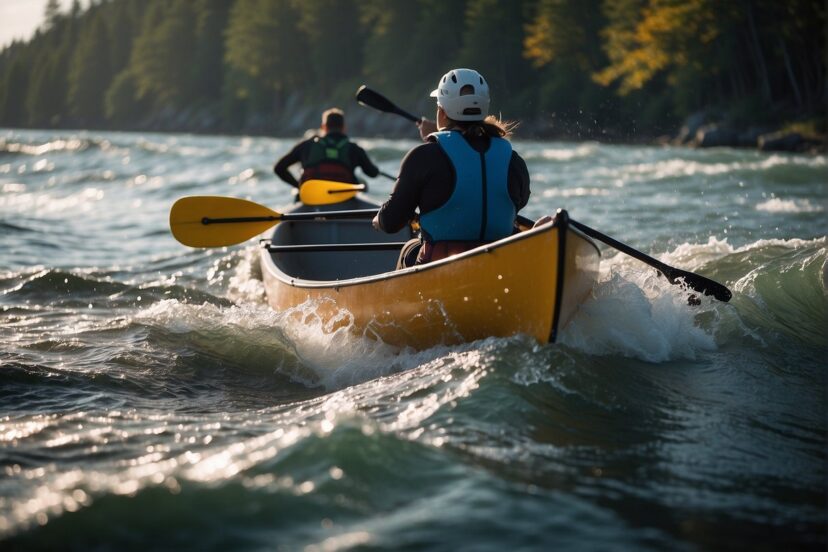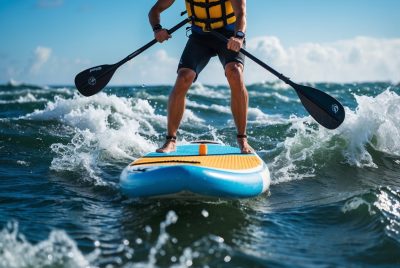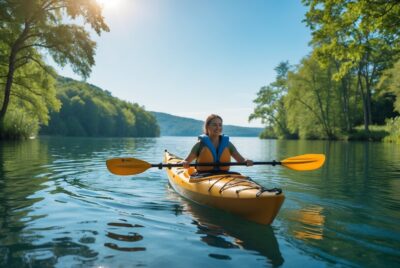Canoeing Essentials: Gear and Techniques
*We may earn a commission for purchases made using our links. Please see our disclosure to learn more.
Canoeing Essentials: Gear and Techniques for the Beginner Paddler
Canoeing is a water sport that involves propelling a canoe through water using a single-bladed paddle. As a versatile activity, it ranges from calm, serene outings on a placid lake to navigating the challenging currents of wild rivers. The canoe itself, a small, narrow boat pointed at both ends, has a historical significance and has been used for transport, fishing, and exploration across various cultures. For many, canoeing serves as a peaceful way to explore nature, get exercise, and even as a competitive sport.

Understanding the basics of canoeing is essential for safety and enjoyment. When I’m preparing to paddle, I always consider factors such as where to sit for optimal balance and control, how to enter and exit the canoe without tipping, and the correct handling of the paddle. Mastering various strokes ensures I can steer effectively and avoid obstacles. On different bodies of water, from tranquil streams to expansive lakes, the paddling techniques may vary, but the fundamental skills remain the same.
Apart from the physical aspect, canoeing offers an opportunity to connect with the environment. Gliding over crystal clear waters or between lush riverbanks allows for an immersive experience in nature that’s both intimate and exhilarating. Moreover, the quietness of a canoe makes it ideal for wildlife watching. While I enjoy the tranquility of a solo trip, canoeing can be equally rewarding as a social activity, fostering teamwork and companionship when undertaken in pairs or groups. Whether it’s for sport, relaxation, or adventure, canoeing appeals to a wide range of enthusiasts seeking enjoyment on the water.
History and Development

While tracking the evolution of canoeing, I’ll explore its ancient roots and its pragmatic uses in war and transportation that have shaped its development. Here, I’ll focus on how canoes served as critical tools in our history and still captivate sports enthusiasts worldwide.
Early Canoeing Origins
Initial evidence of canoe-like watercraft dates back thousands of years, with the oldest known canoes being simple dugouts made from hollowed-out logs. Archaeological findings reveal that these early canoes were essential for transportation, fishing, and trade among indigenous peoples. Their designs varied from region to region, often reflecting the specific needs of their users. For example, the birchbark canoe was crafted by Native Americans using materials readily available to them, combining lightness and durability for efficient movement on water.
In the mid-19th century, John Macgregor significantly advanced canoeing as a recreational sport. His exploits, coupled with his writings, laid the groundwork for modern canoeing, inspiring the formation of the first canoe clubs and popularizing the activity across Europe and North America.
Canoeing in War and Transportation
During wartime, canoes played a strategic role due to their stealth and maneuverability. Their silent approach was beneficial for covert operations, and various armies adapted them for riverine conflicts. Moreover, these crafts were pivotal for transporting goods and people across expanses of water before the modern networks of bridges and roads were established.
For many communities, especially those near rivers and lakes, canoes were the primary means of transportation, allowing trade and communication long before the onset of the industrial revolution. In doing so, they significantly shaped the economic and social landscapes.
In these distinct roles, both for survival and leisure, the history and development of canoeing reveal a profound relationship between humans and waterways. My examination reflects not only the technological advancements and adaptability of these vessels but also their timeless significance in human culture.
Canoe Design and Types

In my experience, canoe design plays a crucial role in the function and performance of the canoe, tailored to the specific needs of the activity, whether it’s tranquil paddling or competitive canoe polo.
Materials and Construction
The materials used in canoe construction significantly affect their weight, durability, and performance. Traditionally, canoes were crafted from wood, but modern ones are often made from more advanced materials such as:
- Aluminum: Durable and low-maintenance, but heavier.
- Fiberglass: Offers a good balance between weight and durability.
- Kevlar: Lightweight and strong, ideal for high-performance canoes.
- Plastic (Polyethylene): Affordable and rugged, suitable for beginners.
Open Canoes vs. Kayaks
While canoes and kayaks may seem similar, distinct features set them apart:
- Canoe: Characterized by an open deck with the paddler either kneeling or sitting on a raised bench, using a single-bladed paddle.
- Kayak: Features a closed deck with the paddler sitting legs-forward, using a double-bladed paddle.
Open canoes offer more space and are often preferred for leisure activities and canoe camping due to their ability to carry more gear.
Specialized Canoes for Racing and Polo
- Canoe Racing: Often involves sleek, lightweight canoes designed for speed and efficiency in flat water (canoe marathon) or navigating gates in whitewater (canoe slalom).
- Canoe Polo: Requires sturdy, agile canoes with a low profile for easy maneuvering during this competitive team sport.
Each specialized canoe is fine-tuned for its purpose, ensuring the best performance for the activity at hand.
Basic Canoeing Techniques

Before venturing on the water, I understand that mastering basic canoeing techniques is essential for safety and enjoyable experience. My approach combines simplicity and effectiveness to ensure I maintain control over my canoe whether I’m on tranquil lakes or in challenging river conditions.
Paddling Strokes and Maneuvers
Forward Stroke: This is the most fundamental stroke I use to propel my canoe forward. I grip the paddle with both hands and alternate strokes on either side of the canoe to continue in a straight line.
J-Stroke: As an adaptation of the forward stroke, the J-stroke helps me steer without changing sides. I start with a standard forward stroke, but towards the end, I turn the paddle inward to create a ‘J’ shape underwater. This action steers the canoe effectively, especially useful when I’m paddling solo.
Draw Stroke: To move the canoe sideways or correct my course, I use the draw stroke. I reach out to the water and pull the paddle towards the canoe, effectively drawing the canoe towards the paddle.
Stern Sweep: Performed from the stern, I reach out with my paddle blade further away from the canoe and sweep back towards the stern to maneuver and steer.
Bow: Here, my job is to set the pace and look out for obstacles. The bow paddler primarily uses forward strokes.
Stern: Positioned at the stern, my responsibility skyrockets with maintaining direction. Implementing the J-stroke and stern sweep are vital tools in my skill set for this role.
Safety Measures and Stability
Low Brace: On encountering waves or a moment of instability, I employ the low brace. I keep my paddle flat on the surface of the water by my side to gain support and prevent capsizing.
To maintain stability, I keep my body centered and balanced, reacting fluidly to the canoe’s movement rather than staying rigid. I always wear a life jacket for safety, regardless of my skill level or the calmness of the water.
Navigating Different Water Conditions
When maneuvering through different water conditions, my techniques adapt slightly:
- On lakes, I can usually be more relaxed with my strokes, given the often tranquil conditions.
- In rivers, I need to be vigilant and responsive. Currents can create challenges, so I use more draw and J-strokes to navigate.
I stay aware of waves that can affect my canoe’s stability, preparing with low braces as required. Learning to read the water’s surface and the flow is crucial – this skill grows with experience.
Advanced Canoeing Skills
c
In my pursuit of advanced canoeing, I have focused on perfecting techniques that enhance speed and efficiency, as well as understanding the nuances of competitive canoeing that take place in various formats, including Olympic Games and marathon events.
Techniques for Speed and Efficiency
I have learned that in advanced canoeing, mastering certain paddling techniques is crucial for maintaining a high level of speed and efficiency. An efficient paddle stroke minimizes water resistance and maximizes stroke power. A vital stroke for maneuvering is the J-stroke, which helps in steering the canoe without the need to switch paddling sides. Additionally, learning to execute precise and powerful forward strokes is key. By using torso rotation and maintaining a loose grip on the paddle, I conserve energy and increase my stroke’s effectiveness.
Key Aspects:
- Torso Rotation: Utilizing core muscles for power.
- Paddle Angle: A vertical paddle angle improves propulsion.
Maintaining a low center of gravity and synchronizing movements with a partner, if in tandem, are essential strategies for experienced paddlers dedicated to both speed and endurance.
Canoeing in Competitive Sports
Canoeing is featured prominently in competitive sports and has established Olympic disciplines, such as canoe sprint and canoe slalom. Sprint events focus on covering distances like 200m, 500m, or 1000m in the shortest time, wherein every stroke counts, and the precision of technique can make the difference between podium placements and narrow misses. In contrast, slalom requires navigating a series of gates on a whitewater course that tests both agility and precision.
Olympic Canoe Sprint:
- Distances: 200m, 500m, 1000m
- Objective: Fastest time possible
Olympic Canoe Slalom:
- Course: Whitewater with gates
- Objective: Navigate with speed and precision
Marathon canoeing is another discipline, typically held on calm water, where stamina and pacing assure an efficient journey over long distances. Here, consistent speed is as important as the ability to surmount the challenges of endurance. As I engage with competitive canoeing, I strive to adapt my skills to the demands of each event, taking into account the subtleties that differentiate marathon from sprint and slalom, and tailoring my approach to succeed in each.
Planning a Canoe Trip

When planning a canoe trip, I focus on the essentials: the right equipment, solid preparation for safety, and picking a fitting destination that suits my experience level.
Selecting the Right Equipment
The basis of any canoe trip is the canoe itself. I choose a stable and durable canoe that is suitable for the waters I plan to navigate. For canoe camping, I ensure there is sufficient space for gear without compromising the canoe’s balance.
- Canoe: Stability and space for gear.
- Paddles: One per person, plus a spare.
- Personal Flotation Device (PFD): Must be worn at all times for safety.
- Safety Kit: Includes items such as a whistle, waterproof flashlight, and a map of the area.
- Repair Kit: Duct tape, multi-tool, and spare parts for emergency repairs.
- Portage Gear: If portaging is expected, lightweight and easy-to-carry equipment is critical.
Preparation and Safety Guidelines
Safety is the foundation of an enjoyable canoe trip. I always wear my life jacket and equip myself with navigation tools and a comprehensive first-aid kit. I check the local weather and water conditions before launching and familiarize myself with the local regulations and permit requirements. Adequate preparation includes:
- Weather Awareness: Check forecasts and prepare for changes.
- Navigation: Waterproof maps, compass, or GPS device.
- Communication: Cell phone in a waterproof case or a satellite messenger.
- First-Aid Kit: Customized to the group size and length of the trip.
- Emergency Plan: Inform someone about my trip itinerary and expected return.
Destinations and Wilderness Canoeing
Choosing the right destination is crucial. I consider my skill level, the length of the trip, and the type of experience I’m seeking. Wilderness areas like the Boundary Waters Canoe Area Wilderness offer remote and challenging opportunities for extended canoe camping, with ample chances to connect with nature. For a less demanding experience, I look for destinations with established campsites and portage trails.
- Skill Level Assessment: Match the trip to my experience.
- Research: Look into specific rules, wildlife, and potential hazards of the area.
- Permits and Regulations: Obtain any necessary permits needed for access to parks and wilderness regions.
- Leave No Trace: Plan to minimize my environmental impact by following Leave No Trace principles.
Frequently Asked Questions
In my experience with canoeing, I’ve come across several inquiries that both novices and seasoned paddlers often ask.
1. What equipment is needed for canoeing?
To go canoeing, you’ll need a canoe, paddles, personal flotation devices (PFDs) for all participants, and proper attire for the weather. Depending on local regulations, your canoe may also need to have a valid license.
2. What are the basic techniques for canoeing?
The foundation of canoeing consists of strokes such as the forward stroke for movement, the reverse stroke for stopping, and the sweep stroke for turning. Efficient paddling also involves proper body positioning and coordination between paddlers in tandem canoeing.
3. How do I choose a canoeing location?
Selecting a canoeing location involves evaluating the waterway’s difficulty, your skill level, and the scenery you wish to enjoy. Always check for any permits or restrictions and consider local weather conditions and wildlife when planning your trip.
4. What safety measures should I take when canoeing?
Safety is paramount when canoeing. Always wear a PFD, understand the basics of water rescue, and be aware of weather conditions. Inform someone of your route and expected return time. It’s also crucial to stay hydrated and protected from the sun.
5. What are the differences between solo and tandem canoeing?
Solo canoeing offers complete control and a meditative experience, while tandem canoeing requires coordination and communication between two paddlers. The choice between the two depends on your preference for solitude or teamwork, as well as the canoe’s design.




